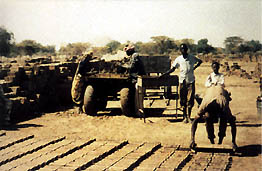| East Africa
article by Reid Harvey
The work of the department head at Sudan University,
Professor Salih El Zakir, has adhered to a meticulously executed
Arabic style. One quite successful alumnus is Yasir Mohammed. Yasir's
elaborately formed pieces are most often unglazed. Large sculptural
vessels are slipcast, with a clay body having no deflocculent. The
plaster used for molds is of a low quality typical in much of Africa
but the addition of 4 percent portland cement helps to give the
molds strength.

Left: At the Khorobhagarat kiln, a brick making team at work.
These soft mud bricks quickly lose their shape.
Across the White Nile from Khartoum, in neighbouring Omdurman,
another ceramic devotee is Dr Ahmed Hassan Hood. To financially
diversify his business making refractory brick, Dr Hood produces
a line of decorative planters and small ziers. As is often the case
in Africa, where shared information can be hard to come by, the
artist must attempt to be a scientist, and vice versa. Dr Hood is
a chemical engineer turned ceramist. Remarkably, with no prior experience
other than research in books, he has begun production of good quality
kaolin firebrick fired to 1400° C. Dr Hood's oil-burning, domed
brick kiln was built through trial and error, and patience. His
own ceramic journey has been one of pure scientific inquiry: an
acquired understanding of what the local materials can do.
Near El Obeid, at Khorobhagarat, the construction of a Hoffman
kiln is a new project of the United Nations Development Program
(UNDP). Firing with heavy fuel oil, an express objective for this
kiln is to reduce the amount of wood fuel used for brick making
in the area. I gave brick forming teams at the kiln some assistance
in using a drier mix of clay. With this improvement, the kiln's
managers were able to achieve improved stacking in the kiln, resulting
in better firing, stronger bricks and reduced fuel consumption.
 Left: Taking a break while carrying water ziers the 15 kilometres
from Dajo to El Obeid market. Below left: Fatimah Hassan with an
earthenware duck. The Vocational Center at El Obeid, Sudan.
Left: Taking a break while carrying water ziers the 15 kilometres
from Dajo to El Obeid market. Below left: Fatimah Hassan with an
earthenware duck. The Vocational Center at El Obeid, Sudan.
Because success in marketing is closely dependent on good technical
skills, in 1992 in the United States, I founded Appropriate Technology
Transfer in Ceramics (ATTIC). My aim was to provide services and
technical information to aspiring ceramists. We distributed two
do-it-yourself manuals. I wrote one on making models and moulds
and another on how to build and operate an inexpensive air-release
ceramic press. We also made available 25 out-of-print technical
papers which give the basics on various ceramic processes and materials.
ATTIC flourished assisting ceramists from the United States and
many other countries, proving that what is appropriate is needed
everywhere and is forever relevant. Appropriate technology is not
only applicable to remote villages in the heart of Africa.
A similar body of information exists in back copies of The American
Ceramic Society Bulletin, also from the 1930s to the '60s but the
demand has not warranted reprinting. Only more recent information,
primarily on advanced ceramics, is being rendered to electronic
libraries. In the 1970s, my initial pursuit of ceramic information
started in Liberia, West Africa. There I worked for 11 years in
glass art and I dabbled in ceramics. I began to notice that Liberia
and neighbouring countries appeared stuck in a cycle of raw materials
exportation and finished goods importation. For export they could
mine iron, cut timber and tap rubber, but they manufactured little.
In Liberia, I walked every day on a path of kaolin, yet I had to
import firebricks for our kiln. Although Liberians and their neighbours
were melting and casting iron and other metals in the 19th century,
it seems that the metal products imported from Europe and the United
States supplanted local products. The metal-working industries closed
and craft traditions were lost. When I saw this, I decided glass
art was too ornamental for me and I could work in ceramics to change
these situations for the better.
Next page > Technology Transfer
in East Africa > 4
More Articles
|